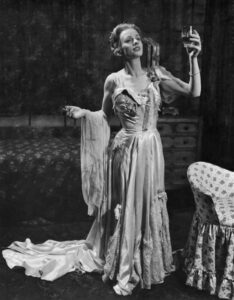Backstage at A Streetcar Named Desire
New THNOC exhibition goes backstage at a classic drama
Published: February 28, 2022
Last Updated: May 31, 2022

The Historic New Orleans Collection
Jessica Tandy as Blanche in the original production.
Undoubtedly our artistic climate is going to change through the world situation. . . . I think there is going to be a vast hunger for life after all this death—and for light after all this eclipse—
People will want to read, see, feel the living truth and they will revolt against the sing-song Mother Goose book of lies that are being fed to them.
-Tennesee Williams, November 29, 1941
A Streetcar Named Desire premiered on Broadway on December 3, 1947, receiving a seven-minute standing ovation. The production went on for a remarkable 855 performances.
The play struck a deep chord in the post–World War II United States, where people struggled to find their places in a rapidly changing social order. Audiences had lived through one of the most violent periods in human history, and to many, the name of Blanche DuBois’s lost ancestral home, Belle Reve—“beautiful dream”—evoked fading prewar notions of morality and societal convention. Viewers were ready to embrace, as Williams had predicted in 1941, “the living truth” of their new era.
In celebration of the seventy-fifth anniversary of this seminal drama, The Historic New Orleans Collection presents Backstage at A Streetcar Named Desire—an exhibition on view at the Brulatour exhibition center, 520 Royal Street, from March 18 through July 3. THNOC’s wide-ranging Tennessee Williams holdings, many of them seldom displayed, are complemented by loans from the Harry Ransom Center, the Whitney Museum of American Art, Victoria and Albert Museum, New York Public Library, and Wesleyan University, among others.
“THIS WOMAN HAD BETTER BE GOOD,” noted an annoyed Williams in a telegram to his literary agent, Audrey Wood, in April 1947. He was referring to Irene Mayer Selznick, whom Wood had chosen to produce the play. Selznick was well connected—she was the daughter of movie mogul Louis B. Mayer and the first wife of producer David O. Selznick.
Selznick proved herself not only by investing her own money, but also by persuading Elia Kazan, the most sought-after Broadway director at the time, to take on the project. Selznick and Kazan put together a legendary cast that made Streetcar an iconic contribution to the history of US theater.
The director’s notebook features extensive, detailed descriptions of the characters as Kazan conceived them—Blanche, for example, is described as “an emblem of a dying civilization, making its last curlicued and romantic exit”—along with notes Williams gave Kazan during rehearsals. Williams himself features as a character in the notebook as well. “Blanche,” Kazan writes, is Williams: “out of place, unappreciated, a stranger in the modern, rough, coarse South.”
Wanting Williams’s blessing to cast Marlon Brando as Stanley, Kazan gave Brando, twenty-three at the time, twenty dollars to travel to Provincetown to do a reading for the playwright. Instead of using the money to pay for travel, Brando and his girlfriend hitchhiked. The actor arrived a few days late, promptly fixed a plumbing emergency for Williams, and then astonished the playwright with his reading. Williams wrote to Wood, “A new value came out of Brando’s reading which was by far the best reading I have ever heard. He seemed to have already created a dimensional character, of the sort that the war has produced among young veterans.”
Brando’s Stanley can be heard menacing Jessica Tandy’s Blanche in a rare recording on exhibit: excerpts of the play produced for radio broadcast. No film exists of Tandy’s acclaimed performance, but the recording offers an auditory glimpse of Blanche as Tandy introduced her to the world.
Selznick’s Hollywood connections and the popularity of the stage production ensured that the film version of the play quickly took shape, with almost all the original Broadway team. Vivien Leigh replaced Jessica Tandy as Blanche at the insistence of Warner Bros.: Leigh had greater box-office appeal, having starred in Gone with the Wind and in the British stage version of Streetcar. Testifying to her success is Leigh’s 1952 Best Actress Oscar statue, which travels across the Atlantic for this exhibition.
Perhaps the biggest challenge in adapting the play for the screen was the script. Guidelines established by the Motion Picture Association of America (MPAA) restricted film content. The MPAA’s censors required numerous changes to the script, which included drastically rewriting the ending to show Stanley being punished for his treatment of Blanche. Despite these major revisions, Kazan’s film proved as popular as the Broadway production.
Streetcar’s reflection of a crumbling social order appealed as much to Latin America, postwar Europe, and beyond as it did to US audiences. Productions in Brazil, Cuba, and Mexico were immediately staged in 1948, and within ten years, important productions had appeared in Greece, Italy, London, Paris, Sweden, Japan, and Korea, and Farsi and Arabic translations were published. The first major Soviet production premiered in 1970, and 1988 saw the first performance of the play in mainland China.
A Streetcar Named Desire has become an icon of the US stage and continues to be translated and performed throughout the world. The play has become a renewable resource in popular culture, inspiring parodies and experimental productions, and its deep connection to fundamental human struggles has been used to explore issues of class, gender, and race in a wide variety of mediums, including a ballet and an opera.
